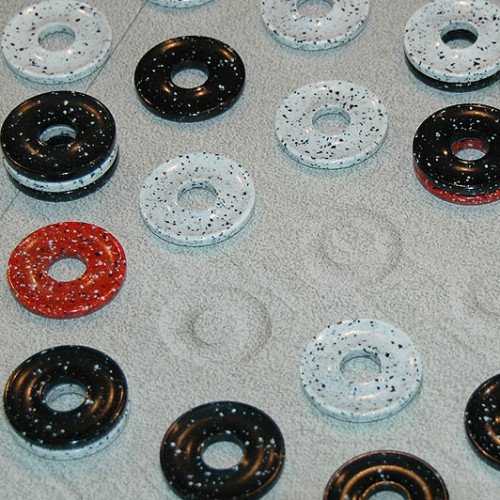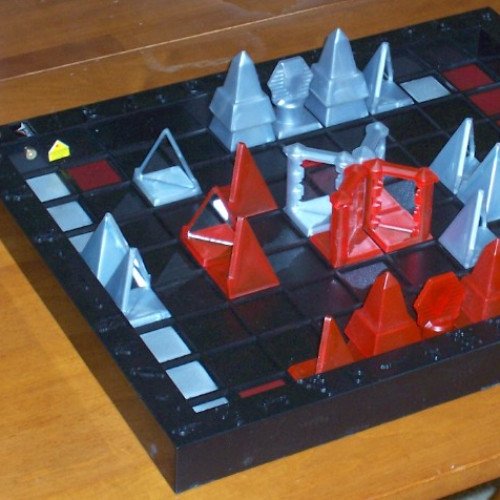DVONN VS KHET

DVONN
DVONN is a two-player strategy board game in which the objective is to accumulate pieces in stacks. It was released in 2001 by Kris Burm as the fourth game of the GIPF Project. DVONN won the 2002 International Gamers Award and the Games magazine Game of the Year Award in 2003. DVONN is played on a board with 49 spaces. The board has a hexagonal layout 5 hexes wide. One player has 23 black pieces to play, the other player has 23 white pieces. There are also 3 neutral red pieces, called DVONN pieces. The object of the game is to control more pieces than your opponent at the end of the game. The game starts with an empty board and proceeds in two phases. During the first phase, the players place their pieces on the board, starting with the three red DVONN pieces. Pieces can be placed on any unoccupied space. White starts, and the players alternate. So Black is the first to place a piece of his own color. The first phase ends when all pieces are placed on the board, filling it completely. The second phase involves the building of stacks of pieces (a single piece is also considered a stack) by moving stacks onto other stacks. A stack is controlled by a player if his color is on top. A stack is immobile if it is surrounded by 6 neighboring stacks. The white player has the first move in this phase. Any mobile stack of height n (with n > 0) can be moved (in a straight line) in any one of the 6 directions by exactly n spaces by the player controlling it, if it lands on another stack. Jumping over empty spaces is allowed, as long as the tower does not land on an empty space. Single DVONN pieces cannot be moved, but they can be once they are part of a stack. After each move, all stacks that are not connected via a chain of neighboring stacks to any stack containing a DVONN piece are removed from the board.
Statistics for this Xoptio

KHET
Khet is a chess-like abstract strategy board game using lasers that was formerly known as Deflexion. Players take turns moving Egyptian-themed pieces around the playing field, firing their low-powered laser diode after each move. Most of the pieces are mirrored on one or more sides, allowing the players to alter the path of the laser through the playing field. When a piece is struck by a laser on a non-mirrored side, it is eliminated from the game. Under its original name, the game was a Mensa Select Award winner. Its name was changed on September 15, 2006. The new game retains the same rules of gameplay, but has a different design, including a new color scheme and a new box design. Under the new name, the game was one of five finalists for the 2007 Toy of the Year award. Professor Michael Larson and two students, Del Segura and Luke Hooper, designed the game as a class project at Tulane University. (Professor Larson is now at the University of Colorado.) The game was introduced to the public in the spring of 2005, and was first brought to prominence at the New York Toy Fair of that year. The game was first shipped in October 2005. The first Deflexion World Championship was held December 10, 2005 under the dome at the Massachusetts Institute of Technology. Registration was free, and the participants competed for cash and other prizes. The winner was an MIT student. Under the new name, Khet, the first Regional Championship took place in April 2006 at the famous Café du Monde in the New Orleans French Quarter. Twenty-four participants competed for a number of prizes. As a special bonus, the Eye of Horus beam splitter was unveiled at the very end, and used by each player in the championship game. Khet was also featured on a recent episode of the HGTV show "I Want That: Tech Toys". Footage from the New Orleans tournament was included in the broadcast. In 2017 a company called "Thinkfun" acquired the license for the now out of print Khet 2.0 and rebranded the game "Laser Chess". Now with a new, modernized scifi look, it brings the exact same rules and feel of Khet 2.0 back to the table.